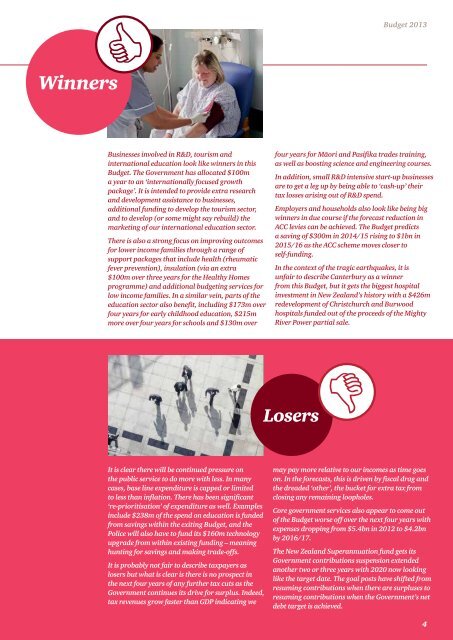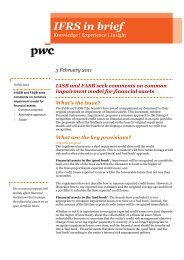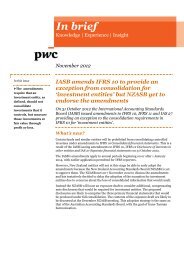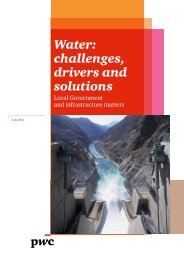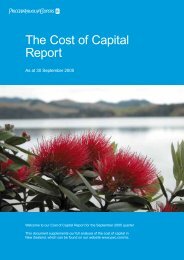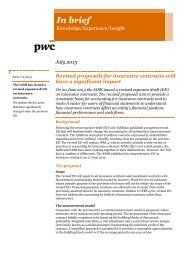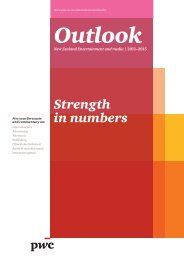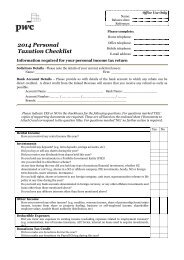New Zealand Budget 2013 - PwC
New Zealand Budget 2013 - PwC
New Zealand Budget 2013 - PwC
Create successful ePaper yourself
Turn your PDF publications into a flip-book with our unique Google optimized e-Paper software.
<strong>Budget</strong> <strong>2013</strong>WinnersBusinesses involved in R&D, tourism andinternational education look like winners in this<strong>Budget</strong>. The Government has allocated $100ma year to an ‘internationally focused growthpackage’. It is intended to provide extra researchand development assistance to businesses,additional funding to develop the tourism sector,and to develop (or some might say rebuild) themarketing of our international education sector.There is also a strong focus on improving outcomesfor lower income families through a range ofsupport packages that include health (rheumaticfever prevention), insulation (via an extra$100m over three years for the Healthy Homesprogramme) and additional budgeting services forlow income families. In a similar vein, parts of theeducation sector also benefit, including $173m overfour years for early childhood education, $215mmore over four years for schools and $130m overfour years for Māori and Pasifika trades training,as well as boosting science and engineering courses.In addition, small R&D intensive start-up businessesare to get a leg up by being able to ‘cash-up’ theirtax losses arising out of R&D spend.Employers and households also look like being bigwinners in due course if the forecast reduction inACC levies can be achieved. The <strong>Budget</strong> predictsa saving of $300m in 2014/15 rising to $1bn in2015/16 as the ACC scheme moves closer toself-funding.In the context of the tragic earthquakes, it isunfair to describe Canterbury as a winnerfrom this <strong>Budget</strong>, but it gets the biggest hospitalinvestment in <strong>New</strong> <strong>Zealand</strong>’s history with a $426mredevelopment of Christchurch and Burwoodhospitals funded out of the proceeds of the MightyRiver Power partial sale.LosersIt is clear there will be continued pressure onthe public service to do more with less. In manycases, base line expenditure is capped or limitedto less than inflation. There has been significant‘re-prioritisation’ of expenditure as well. Examplesinclude $238m of the spend on education is fundedfrom savings within the exiting <strong>Budget</strong>, and thePolice will also have to fund its $160m technologyupgrade from within existing funding – meaninghunting for savings and making trade-offs.It is probably not fair to describe taxpayers aslosers but what is clear is there is no prospect inthe next four years of any further tax cuts as theGovernment continues its drive for surplus. Indeed,tax revenues grow faster than GDP indicating wemay pay more relative to our incomes as time goeson. In the forecasts, this is driven by fiscal drag andthe dreaded ‘other’, the bucket for extra tax fromclosing any remaining loopholes.Core government services also appear to come outof the <strong>Budget</strong> worse off over the next four years withexpenses dropping from $5.4bn in 2012 to $4.2bnby 2016/17.The <strong>New</strong> <strong>Zealand</strong> Superannuation fund gets itsGovernment contributions suspension extendedanother two or three years with 2020 now lookinglike the target date. The goal posts have shifted fromresuming contributions when there are surpluses toresuming contributions when the Government’s netdebt target is achieved.4


